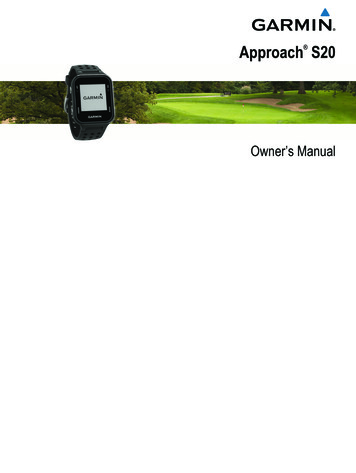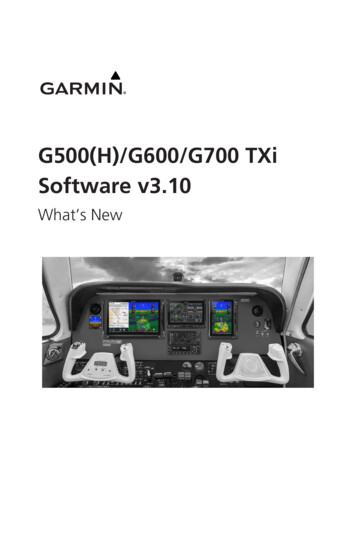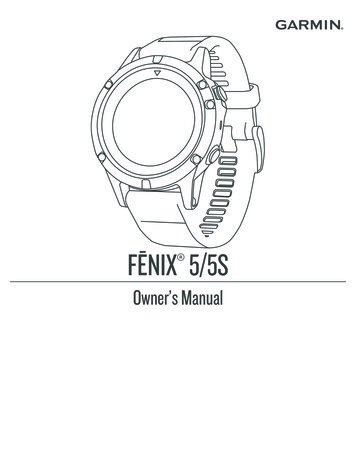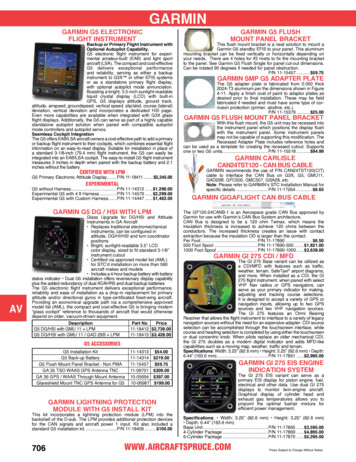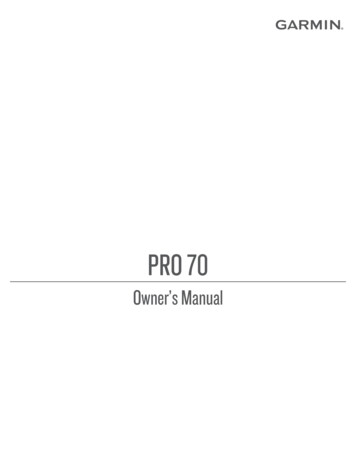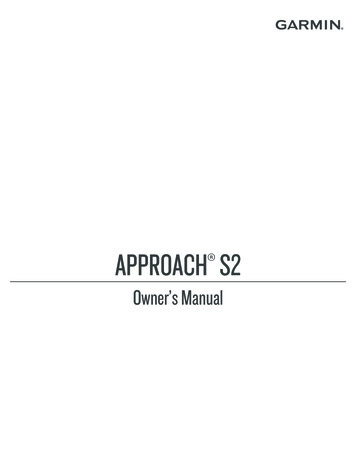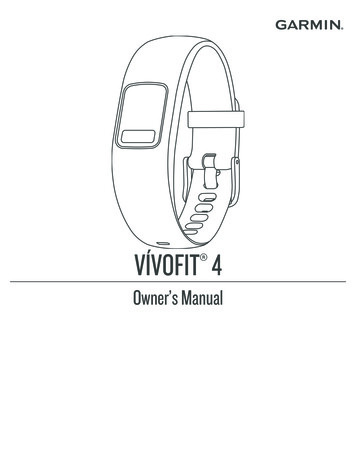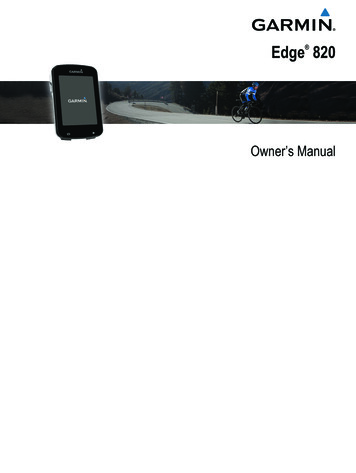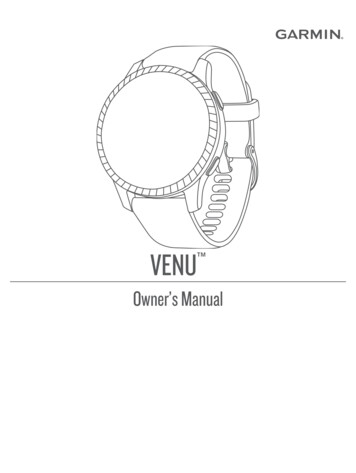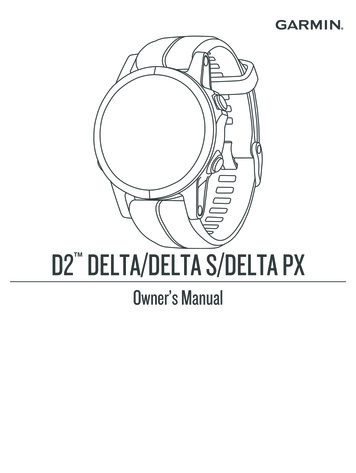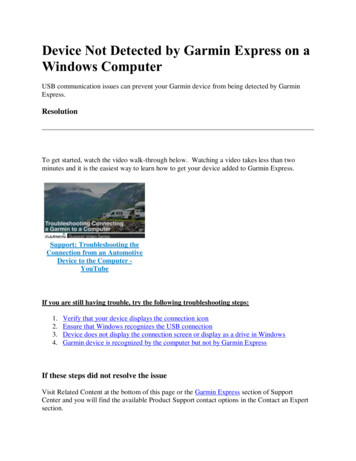
Transcription
Garmin Drive 5Owner’s Manual
2017 Garmin Ltd. or its subsidiariesAll rights reserved. Under the copyright laws, this manual may not be copied, in whole or in part, without the written consent of Garmin. Garmin reserves the right to change or improve itsproducts and to make changes in the content of this manual without obligation to notify any person or organization of such changes or improvements. Go to www.garmin.com for current updatesand supplemental information concerning the use of this product.Garmin and the Garmin logo are trademarks of Garmin Ltd. or its subsidiaries, registered in the USA and other countries. These trademarks may not be used without the express permission ofGarmin. Garmin Drive , Garmin Express , myTrends , nüMaps Guarantee , and nüMaps Lifetime are trademarks of Garmin Ltd. or its subsidiaries. These trademarks may not be used without theexpress permission of Garmin.Android is a trademark of Google Inc. Apple and Mac are trademarks of Apple Inc, registered in the U.S. and other countries. Foursquare is a trademark of Foursquare Labs, Inc. in the U.S.and in other countries. microSD and the microSDHC logo are trademarks of SD-3C, LLC. Windows , Windows Vista , and Windows XP are registered trademarks of Microsoft Corporation inthe United States and other countries.
Getting StartedWARNINGSee the Important Safety and Product Information guide in theproduct box for product warnings and other importantinformation. Update the maps and software on your device (UpdatingMaps and Software with Garmin Express, page 1). Mount the device in your vehicle and connect it to power(Connecting the Device to Vehicle Power, page 1). Acquire GPS signals (Acquiring GPS Signals, page 2). Adjust the volume (Adjusting the Volume, page 2) anddisplay brightness (Adjusting the Screen Brightness,page 2). Navigate to your destination (Starting a Route, page 3).7 Click Add Device.8 Follow the on-screen instructions to add your device to theGarmin Express software.When setup is complete, the Garmin Express softwaresearches for map and software updates for your device.9 Select an option: To install all available updates, click Install All. To install a single update, click View Details and select anupdate.Support and UpdatesGarmin Express (garmin.com/express) provides easy accessto these services for Garmin devices. Product registration Product manuals Software updates Map, chart, or course updatesThe Garmin Express software downloads and installs theupdates onto your device. Map updates are very large, and thisprocess may take a long time on slower Internet connections.Updating Maps and Software with Garmin ExpressGarmin Drive 5 Device Overview You can use Garmin Express software to download and installthe latest map and software updates for your device. Mapupdates provide the latest available mapping data to ensureyour device continues to calculate accurate and efficient routesto your destinations. Garmin Express is available for Windowsand Mac computers.1 On your computer, go to www.garmin.com/express. ÀÁÂPower keyUSB power and data portMap and data memory card slotConnecting the Device to Vehicle Power2 Select an option: To install on a Windows computer, select Download forWindows. To install on a Mac computer, select Download for Mac.3 Open the downloaded file, and follow the on-screeninstructions to complete the installation.4 Start Garmin Express.5 Connect your Garmin device to your computer using a USBcable.6 Click Add a Device.The Garmin Express software detects your device.Getting StartedWARNINGThis product contains a lithium-ion battery. To prevent thepossibility of personal injury or product damage caused bybattery exposure to extreme heat, store the device out of directsunlight.Before you use your device on battery power, you should chargeit.1 Plug the vehicle power cable À into the USB port on thedevice.2 Press the mount Á onto the suction cup  until it snaps intoplace.1
3 Press the suction cup to the windshield, and flip the lever Ãback toward the windshield.4 Fit the tab on the top of the mount into the slot on the back ofthe device.Pressthe bottom of the mount into the device until it clicks.56 Plug the other end of the vehicle power cable into a poweroutlet in your vehicle.Turning the Device On or Off To turn the device on, press the power key, or connect thedevice to power. To put the device in power saving mode, press the power keywhile the device is on.While in power saving mode, the screen is off and the deviceuses very little power, but it can wake instantly for use.TIP: You can charge your device faster by putting it in powersaving mode while charging the battery. To turn off the device completely, hold the power key until aprompt appears on the screen, and select Off.The prompt appears after five seconds. If you release thepower key before the prompt appears, the device enterspower saving mode.Acquiring GPS SignalsWhen you turn on your navigation device, the GPS receivermust collect satellite data and establish the current location.in the status bar indicates the satellite signal strength. The timerequired to acquire satellite signals varies based on severalfactors, including how far you are from the location where youlast used your navigation device, whether you have a clear viewof the sky, and how long it has been since you last used yournavigation device. The first time you turn on your navigationdevice, it may take several minutes to acquire satellite signals.1 Turn on the device.2 Wait while the device locates satellites.3 If necessary, go outdoors to an open area, away from tallbuildings and trees.Whenturns green, the device has acquired satellite signalsand is ready for navigation.Status Bar IconsThe status bar is located at the top of the main menu. The statusbar icons display information about features on the device. Youcan select some icons to change settings or view additionalinformation.GPS signal status. Hold to view GPS accuracy and acquiredsatellite information (Viewing GPS Signal Status, page 13).Current time. Select to set the time (Setting the Time,page 11).Battery charge level.Using the On-Screen ButtonsOn-screen buttons allow you to navigate the pages, menus, andmenu options on your device. Selectto return to the previous menu screen. Holdto quickly return to the main menu. Select or to scroll through lists or menus. Hold or to scroll faster. Selectto see a context-based menu of options for thecurrent screen.Adjusting the Volume2 Select an option: Use the slider bar to adjust the volume. Select to mute the device. Select for additional options.Adjusting the Screen Brightness1 Select Settings Display Brightness.2 Use the slider bar to adjust the brightness.Driver Awareness Features and AlertsNOTICEThe driver alerts and speed limit features are for informationonly and do not replace your responsibility to abide by all postedspeed limit signs and to use safe driving judgment at all times.Garmin is not responsible for any traffic fines or citations youreceive for failing to follow all applicable traffic laws and signs.Your device provides features that can help encourage saferdriving and increase efficiency, even when you are driving in afamiliar area. The device plays an audible tone or message anddisplays information for each alert. You can enable or disablethe audible tone or message for each type of alert. Not all alertsare available in all areas.School zone or nearby school: The device plays a tone anddisplays the distance to and speed limit (if available) for anupcoming school or school zone.Speed limit reduction: The device plays a tone and displaysthe upcoming reduced speed limit so you can be prepared toreduce your speed.Speed limit exceeded: The device plays a tone and displays ared border on the speed limit icon when you exceed theposted speed limit for the current road.Wrong way on a one-way street: The device plays a messageand displays a full-screen warning if you travel the wrong wayon a one-way street. The edges of the screen appear red andan alert remains at the top of the screen until you leave theone-way street or correct your direction of travel.Railroad crossing: The device plays a tone and displays thedistance to an upcoming railroad crossing.Animal crossing: The device plays a tone and displays thedistance to an upcoming animal crossing area.Curve: The device plays a tone and displays the distance to acurve in the road.Slower traffic: The device plays a tone and displays thedistance to slower traffic when you approach slower traffic ata higher speed. Your device must be receiving trafficinformation to use this feature (Receiving Traffic Data Usinga Traffic Receiver, page 9).Fatigue warning: The device plays a tone and suggestsupcoming rest stops after you have been driving for morethan two hours without stopping.Enabling or Disabling Audible Driver AlertsYou can turn off individual audible driver alerts. The visual alertappears even when the audible alert is disabled.1 Select Settings Map & Vehicle Audible Driver Alerts.2 Select or clear the check box next to each alert.Red Light and Speed CamerasNOTICEGarmin is not responsible for the accuracy of or theconsequences of using a red light or speed camera database.1 Select Volume.2Driver Awareness Features and Alerts
NOTE: This feature is not available for all regions or productmodels.Information about red light and speed camera locations isavailable in some areas for some product models. Go togarmin.com/speedcameras to check availability andcompatibility, or to purchase a subscription or one-time update.You can purchase a new region or extend an existingsubscription at any time.You can go to mygarmin.com to update the camera database onyour device. You should update your device frequently toreceive the most up-to-date camera information.For some devices and regions, basic red light or speed cameradata may be included with your device. Included data does notinclude updates or a subscription.Navigating to Your Destination5 Select Go!.Going HomeThe first time you start a route home, the device prompts you toenter your home location.1 Select Where To? Go Home.2 If necessary, enter your home location.Editing Your Home Location1 Select Where To? Set Home Location.2 Enter your home location.Your Route on the MapAs you travel, the device guides you to your destination usingvoice prompts and information on the map. Instructions for yournext turn or exit, or other actions appear across the top of themap.RoutesA route is a path from your current location to one or moredestinations. The device calculates a recommended route to yourdestination based on the preferences you set, including theroute calculation mode (Changing the Route CalculationMode, page 4) and avoidances (Avoiding Delays, Tolls,and Areas, page 5). You can start navigating to your destination quickly using therecommended route, or you can select an alternate route(Starting a Route, page 3). If there are specific roads you need to use or avoid, you cancustomize the route (Shaping Your Route, page 4). You can add multiple destinations to a route (Adding aLocation to Your Route, page 3).Starting a Route1 Select Where To?, and search for a location (Finding andSaving Locations, page 6).2 Select a location.3 Select an option: To start navigating using the recommended route, selectGo!. To choose an alternate route, select , and select a route.Alternate routes appear to the right of the map. To edit the course of the route, select Edit Route, andadd shaping points to the route (Shaping Your Route,page 4).The device calculates a route to the location and guides youusing voice prompts and information on the map (Your Route onthe Map, page 3). A preview of the major roads in your routeappears at the edge of the map for several seconds.If you need to stop at additional destinations, you can add thelocations to your route (Adding a Location to Your Route,page 3).Starting a Route by Using the MapYou can start route by selecting a location from the map.1 Select View Map.2 Drag and zoom the map to display the area to search.3 If necessary, select to filter the displayed points of interestby category.Location markers ( or a blue dot) appear on the map.4 Select an option: Select a location marker. Select a point, such as a street, intersection, or addresslocation.Navigating to Your DestinationÀÁÂÃÄÅÆÇNext action in the route. Indicates the next turn, exit, or other actionand the lane in which you should travel, if available.Distance to the next action.Name of the street or exit associated with the next action.Route highlighted on the map.Next action in the route. Arrows on the map indicate the location ofupcoming actions.Vehicle speed.Name of the road on which you are traveling.Estimated arrival time.TIP: You can touch this field to change the information it shows(Changing the Map Data Field, page 9).Viewing Turns and DirectionsWhile navigating a route, you can view upcoming turns, lanechanges, or other directions for your route.1 From the map, select an option: To view upcoming turns and directions as you navigate,select Turns.The map tool displays the next four turns or directionsbeside the map. The list updates automatically as younavigate the route. To view the complete list of turns and directions for theentire route, select the text bar at the top of the map.2 Select a turn or direction (optional).Detailed information appears. An image of the junction mayappear for junctions on major roadways, if available.Viewing the Entire Route on the Map1 While navigating a route, select anywhere on the map.2 Select .Adding a Location to Your RouteBefore you can add a location to your route, you must benavigating a route (Starting a Route, page 3).3
You can add locations to the middle or end of your route. Forexample, you can add a fuel station as the next destination inyour route.TIP: To create complex routes with multiple destinations orscheduled stops, you can use the trip planner to plan, schedule,and save a trip (Planning a Trip, page 4).1 From the map, select Where To?.2 Search for a location (Finding and Saving Locations,page 6).3 Select a location.4 Select Go!.5 Select an option: To add the location as the next destination in your route,select Add As Next Stop. To add the location to the end of your route, select AddAs Last Stop. To add the location and edit the order of destinations inyour route, select Add to Active Route.The device re-calculates the route to include the added locationand guides you to the destinations in order.Shaping Your RouteBefore you can shape your route, you must start a route(Starting a Route, page 3).You can manually shape your route to change its course. Thisallows you to direct the route to use a certain road or go througha certain area without adding a destination to the route.1 Touch anywhere on the map.2 Select .The device enters route shaping mode.3 Select a location on the map.TIP: You can select to zoom in on the map and select amore precise location.The device recalculates the route to travel through theselected location.4 If necessary, select an option: To add more shaping points to the route, select additionallocations on the map. To remove a shaping point, select .5 When you are finished shaping the route, select Go!.You can take a detour for a specified distance along your routeor detour around specific roads. This is useful if you encounterconstruction zones, closed roads, or poor road conditions.1 From the map, select Change Route.TIP: If the Change Route tool is not in the map tools menu,you can add it (Enabling Map Tools, page 8).2 Select an option: To detour your route for a specific distance, select Detourby Distance. To detour around a specific road on the route, selectDetour by Road. To find a new route, select Detour.Stopping the Route Stop.Changing the Route Calculation Mode1 Select Settings Navigation Calculation Mode.2 Select an option:4Trip PlannerYou can use the trip planner to create and save a trip, which youcan navigate later. This can be useful for planning a deliveryroute, a vacation, or a road trip. You can edit a saved trip tofurther customize it, including reordering locations, optimizingthe order of stops, adding scheduling information, and addingshaping points.You can also use the trip planner to edit and save your activeroute.Planning a TripA trip can include many destinations, and it must include at leasta starting location and one destination. The starting location isthe location from which you plan to start your trip. If you startnavigating the trip from a different location, the device gives youthe option to route to your starting location first. For a round trip,the starting location and final destination can be the same.1 Select Apps Trip Planner Create Trip.2 Select Select Start Location.3 Choose a location for your starting point, and select Select.4 Select Select Destination.5 Choose a location for a destination, and select Select.6 Select Add Location to add more locations (optional).7 After you have added all the necessary locations, select Next Save.8 Enter a name, and select Done.Navigating to a Saved Trip1 Select Apps Trip Planner.2 Select a saved trip.3 Select Go!.4 Select the first location to navigate to, and select Start.The device calculates a route from your current location tothe selected location and then guides you to the remainingtrip destinations in order.Optimizing the Order of Destinations in a TripTaking a DetourFrom the map, select Select Faster Time to calculate routes that are faster todrive but can be longer in distance. Select Off Road to calculate point-to-point routes (withoutroads). Select Shorter Distance to calculate routes that areshorter in distance but can take more time to drive.The device can automatically optimize the order of destinationsin your trip to create a shorter, more efficient route. The startinglocation and final destination are not changed when youoptimize the order.While editing a trip, select Optimize Order.Editing and Reordering Locations in a Trip1 Select Apps Trip Planner.2 Select a saved trip.3 Select a location.4 Select an option: To move the location up or down, select , and drag thelocation to a new position in the trip. To add a new location after the selected location, select. To remove the location, select .Editing and Saving Your Active RouteIf a route is active, you can use the trip planner to edit and saveyour route as a trip.1 Select Apps Trip Planner My Active Route.Navigating to Your Destination
2 Edit your route using any of the trip planner features.The route recalculates each time you make a change.SelectSave to save your route as a trip, which you can3navigate again later (optional).Changing Routing Options for a TripYou can customize how the device calculates the route whenyou start your trip.1 Select Apps Trip Planner.2 Select a saved trip.3 Select Trip Settings.4 Select an option: To add shaping points to your trip, select Shape Route,and follow the on-screen instructions (Shaping YourRoute, page 4). To change the calculation mode for the trip, select RoutePreference (Changing the Route Calculation Mode,page 4).Scheduling a TripYou can add scheduling information to each location in your trip,including the desired arrival time and layover duration at eachlocation. This can help you plan your departure to reachlocations in your trip on time.1 Select Apps Trip Planner.2 Select a trip.3 Select Trip Settings Edit Schedule.4 Select a location, and follow the on-screen instructions toenter the schedule information.TIP: If you need to schedule multiple locations in the trip, youshould start from the beginning of the trip and work towardthe end.5 Repeat step 4 to enter schedule information for additionallocations.6 When finished, select Save.When you navigate the trip, you should depart by the timeshown under the starting point to reach your stops anddestinations by the scheduled time. The schedule is an estimateonly. Traffic conditions, construction, and other delays mayaffect your actual arrival times.Using Suggested RoutesBefore you can use this feature, you must save at least onelocation and enable the travel history feature (Device andPrivacy Settings, page 11).Using the myTrends feature, your device predicts yourdestination based on your travel history, the day of the week,and the time of day. After you have driven to a saved locationseveral times, the location may appear in the navigation bar onthe map, along with the estimated time of travel, and trafficinformation.Select the navigation bar to view a suggested route to thelocation.Avoiding Delays, Tolls, and AreasAvoiding Traffic Delays on Your RouteBefore you can avoid traffic delays, you must be receiving trafficinformation (Receiving Traffic Data Using a Traffic Receiver,page 9).By default, the device optimizes your route to avoid traffic delaysautomatically. If you have disabled this option in the trafficsettings (Traffic Settings, page 11), you can view and avoidtraffic delays manually.1 While navigating a route, select Traffic.Navigating to Your Destination2 Select Alternate Route, if available.3 Select Go!.Avoiding Toll RoadsYour device can avoid routing you through areas that requiretolls, such as toll roads, toll bridges, or congestion areas. Thedevice may still include a toll area in your route if no otherreasonable routes are available.1 Select Settings Navigation.2 Select an option:NOTE: The menu changes based on your area and the mapdata on your device. Select Toll Roads. Select Tolls and Fees Toll Roads.3 Select an option: To be asked each time before routing through a toll area,select Always Ask. To always avoid tolls, select Avoid. To always allow tolls, select Allow.4 Select Save.Avoiding Toll StickersNOTE: This feature is not available in all areas.The map data on your device may contain detailed toll stickerinformation for some countries. You can avoid or allow tollstickers for each country.1 Select Settings Navigation Tolls and Fees TollStickers.2 Select a country.3 Select an option: To be asked each time before routing through a toll area,select Always Ask. To always avoid tolls, select Avoid. To always allow tolls, select Allow.4 Select Save.Avoiding Road Features1 Select Settings Navigation Avoidances.2 Select the road features to avoid on your routes, and selectSave.Avoiding Environmental ZonesYour device can avoid areas with environmental or emissionsrestrictions that may apply to your vehicle.1 Select Settings Navigation Environmental Zones.2 Select an option: To be asked each time before routing through anenvironmental zone, select Always Ask. To always avoid environmental zones, select Avoid. To always allow environmental zones, select Allow.SelectSave.3Custom AvoidancesCustom avoidances allow you select specific areas or sectionsof road to avoid. When the device calculates a route, it avoidsthese areas and roads unless no other reasonable route isavailable.Avoiding a Road1 Select Settings Navigation Custom Avoidances.2 Select Add Avoid Road.3 Select the starting point of the section of road to avoid, andselect Next.4 Select the ending point of the road section, and select Next.5
5 Select Done.4 Select an option:Avoiding an Area1 Select Settings Navigation Custom Avoidances.2 If necessary, select Add Avoidance.3 Select Add Avoid Area.4 Select the upper-left corner of the area to avoid, and selectNext.5 Select the lower-right corner of the area to avoid, and selectNext.The selected area is shaded on the map.6 Select Done. To search for a type of business, enter a category name(for example, "movie theaters"). To search for a business name, enter all or part of thename. To search for an address near you, enter the housenumber and street name. To search for an address in another city, enter the housenumber, street name, city, and state. To search for a city, enter the city and state. To search for coordinates, enter latitude and longitudecoordinates.5 Select an option: To search using a suggested search term, select the term. To search using the text you entered, select .6 If necessary, select a location.Disabling a Custom AvoidanceYou can disable a custom avoidance without deleting it.1 Select Settings Navigation Custom Avoidances.2 Select an avoidance.3 Select Disable.Deleting Custom Avoidances1 Select Settings Navigation Custom Avoidances.2 Select an option: To delete all custom avoidances, select . To delete one custom avoidance, select the avoidance,and select Delete.Navigating Off RoadIf you are not following roadways as you navigate, you can useOff Road mode.1 Select Settings Navigation.2 Select Calculation Mode Off Road Save.The next route will be calculated as a straight line to thelocation.Finding and Saving LocationsThe maps loaded in your device contain locations, such asrestaurants, hotels, auto services, and detailed streetinformation. The Where To? menu helps you find yourdestination by providing several methods to browse, search, andsave this information. Enter search terms to quickly search all location information(Finding a Location Using the Search Bar, page 6). Browse or search pre-loaded points of interest by category(Points of Interest, page 6). Search Foursquare points of interest (Searching FoursquarePoints of Interest, page 7). Use search tools to find specific locations, such asaddresses, intersections, or geographic coordinates (SearchTools, page 7). Search near a different city or area (Changing the SearchArea, page 6). Save your favorite locations to find them quickly in the future(Saving Locations, page 7). Return to recently found locations (Viewing Recently FoundLocations, page 7).Viewing Search Results on the MapYou can view the results of a location search on the map insteadof in a list.1 From the location search results, select .The nearest location in your search results appears on themap. indicates the locations of other search results.2 Select one or more options: To view more search results, touch and drag the map. To select another location, select . To view details and routes for the selected location, selectthe location description at the bottom of the map. To start navigation to the selected location, select Go!.Changing the Search AreaBy default, the device searches near your current location. Youcan also search other areas, such as near your destination, nearanother city, or along your active route.1 From the main menu, select Where To?.2 Select .3 Select an option.Points of InterestA point of interest is a place that you may find useful orinteresting. Points of interest are organized by category and caninclude popular travel destinations such as gas stations,restaurants, hotels, and entertainment venues. Finding a Location Using the Search BarYou can use the search bar to search for locations by entering acategory, brand name, address, or city name.1 Select Where To?.2 Select Enter Search in the search bar.3 Enter all or part of the search term.Suggested search terms appear below the search bar.6Finding a Location by Category1 Select Where To?.2 Select a category, or select Categories.3 If necessary, select a subcategory.4 Select a location.Searching Within a CategoryAfter you have performed a search for a point of interest, certaincategories may display a Quick Search list that shows the lastfour destinations you selected.1 Select Where To? Categories.2 Select a category.3 Select an option: Select a destination from the quick search list on the rightside of the screen.The quick search list provides a list of recently foundlocations in the selected category.Finding and Saving Locations
Select a subcategory, if necessary, and select adestination.FoursquareFoursquare is a location-based social network. Your deviceincludes pre-loaded Foursquare points of interest, which areindicated by the Foursquare logo in your location search results.Searching Foursquare Points of InterestYou can search for Foursquare points of interest loaded on yourdevice.Select Where To? Categories Foursquare .Search ToolsSearch tools allow you to search for specific types of locationsby responding to on-screen prompts.Finding an AddressNOTE: The order of the steps may change depending on themap data loaded on your device.1 Select Where To?.2 If necessary, select Searching near: to change the searcharea (Changing the Search Area, page 6).3 Select Address.4 Follow the on-screen instructions to enter addressinformation.5 Select the address.Finding an IntersectionYou can search for an intersection or junction between twostreets, highways, or other roads.1 Select Where To? Categories Intersections.2 Follow the on-screen instructions to enter street information.3 Select the intersection.Finding a City1 Select Where To? Categories Cities.2 Select an option: Select a city from the list of nearby cities. To search near another location, select Searching near:(Changing the Search Area, page 6). To search for a city by name, select Enter Search, enter acity name, and select .Finding a Location Using CoordinatesYou can find a location using latitude and longitude coordinates.This can be helpful when geocaching.1 Select Where To? Categories Coordinates.2 If necessary, select , and change the coordinate format ordatum.3 Enter the latitude and longitude coordinates.4 Select View on Map.Viewing Recently Found LocationsYour device stores a history of the last 50 locations you havefound.Select Where To? Recent.Clearing the List of Recently Found LocationsSelect Where To? Recent Clear Yes.Finding Your Last Parking SpotWhen you disconnect the device from vehicle power while thedevice is on, your current location is saved as a parking spot.Select Apps Last Spot.Finding and Saving LocationsViewing C
3 Press the suction cup to the windshield, and flip the lever à back toward the windshield. 4 Fit the tab on the top of the mount into the slot on the back of the device. 5 Press the bottom of the mount into the device until it clicks. 6 Plug the other end of the vehicle power cable into a power outlet in your vehicle. Turning the Device On or Off To turn the device on, press the power .
